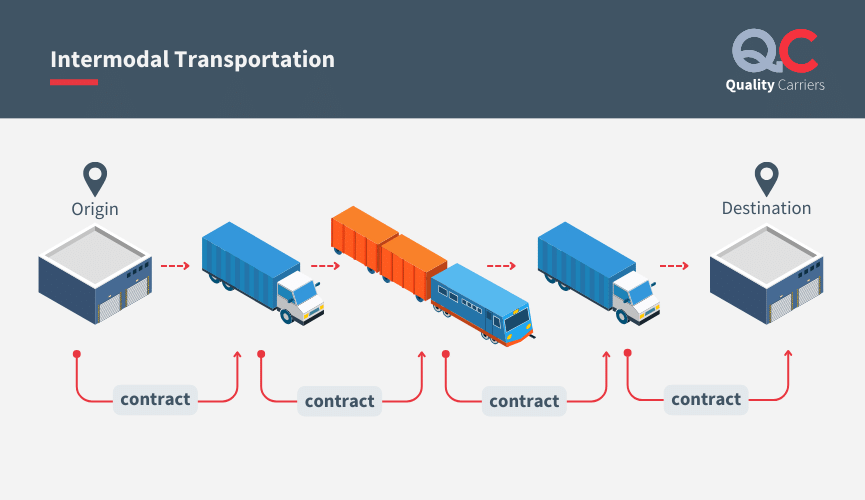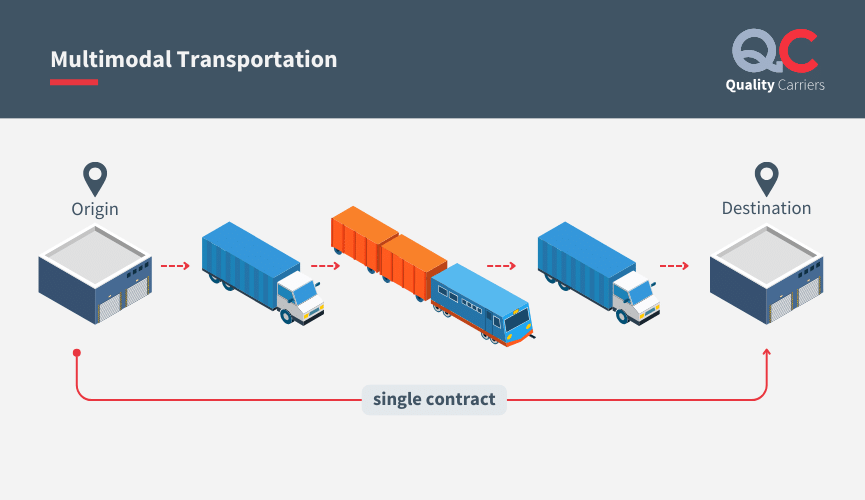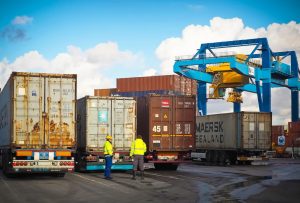In the logistics and transportation industry, the concepts of intermodal and multimodal transport often surface, each representing unique approaches to moving goods across various modes of transportation. Businesses must comprehend these distinctions to streamline their supply chain operations and improve efficiency.
In this blog, we delve into the fundamental dissimilarities between intermodal and multimodal transport, shedding light on their respective characteristics, operational nuances, and implications for logistical decision-making. Whether you’re a logistics professional, a business owner, or simply curious about the intricacies of modern transportation systems, this exploration will provide valuable insights into the diverse landscape of freight movement.
What is Intermodal Transportation?

Intermodal transportation involves utilizing various modes of transport during a single journey to transport goods. The cargo is transferred between modes of transportation, like trucks, trains, ships, or planes, using standardized containers or trailers. This approach allows seamless transitions between various transportation networks, optimizing efficiency and reducing costs. Intermodal transportation is commonly used for long-distance freight movements, offering flexibility, reliability, and sustainability in supply chain operations.
Types of Intermodal Transportation
Intermodal transportation encompasses two primary methods: Container-On-Flat-Car (COFC) and Trailer-On-Flat-Car (TOFC).
- Container-On-Flat-Car (COFC): In COFC transport, goods are packed into standardized containers, which are then loaded onto flat railway cars for transportation. These containers are designed to fit securely onto the railcars, ensuring stability and ease of handling. COFC transport various cargo, including consumer goods, perishables, and industrial materials.
- Trailer-On-Flat-Car (TOFC): TOFC involves loading entire trailers or semi-trailers onto specially designed flat railway cars for transport. Unlike COFC, which uses standardized containers, TOFC allows for the direct loading of trailers onto railcars. This method is particularly suitable for transporting oversized or irregularly shaped cargo that may not fit into standard containers. TOFC is common for transporting goods over long distances, offering flexibility and convenience for shippers.
How Intermodal Transportation Works?
Intermodal transport integrates multiple modes like rail, road, sea, and air to move goods efficiently. Initially, goods are loaded onto trucks or trains, then transferred at intermodal terminals, often onto trains for long-distance haulage. Finally, trucks complete the delivery to the destination. This approach optimizes each mode’s strengths, leading to streamlined logistics and improved supply chain performance.
Advantages and Disadvantages of Intermodal Transportation
Advantages:
- Cost Efficiency: Utilizing multiple modes optimizes cost by choosing the most economical options for each leg of the journey.
- Environmental Benefits: Reduced fuel consumption and emissions per ton-mile compared to single-mode transport.
- Reliability: Diverse routes and redundancy in the system minimize disruptions caused by weather, accidents, or infrastructure issues.
- Increased Capacity: Intermodal systems can handle larger freight volumes, enhancing overall logistics capabilities.
- Flexibility: Ability to adapt to changing market conditions and route goods efficiently based on demand.
Disadvantages:
- Complexity: Coordinating between different modes of transport and terminals can be challenging and require sophisticated logistics management.
- Infrastructure Requirements: Intermodal terminals and equipment necessitate significant investment and maintenance.
- Longer Transit Times: In some cases, multiple modes can lead to longer overall transit times than direct transport.
- Potential for Damage or Loss: Transfers between various modes increase the risk of damage or loss of goods without proper handling procedures.
- Regulatory and Legal Issues: Different jurisdictions and regulations across modes may pose compliance challenges and administrative burdens.
What is Multimodal Transportation?

Multimodal transportation uses two or more modes of transportation under a single contract, with one carrier overseeing the entire journey. This approach integrates various modes such as road, rail, air, and sea transport. This optimizes efficiency, reliability, and cost-effectiveness in transporting cargo from origin to destination. It offers a seamless and coordinated logistics solution, allowing shippers to leverage the strengths of different transport modes while mitigating their limitations.
How Multimodal Transportation Works?
Multimodal transportation involves the seamless coordination of different modes of transportation to move goods from one location to another. It typically begins with the shipper or freight forwarder arranging for the cargo to be collected from its origin point. The cargo may travel by truck to a rail terminal, airport, or seaport, depending on the specific route and destination. At the terminal, the cargo is transferred onto the appropriate transport mode, whether a train, airplane, or ship. Throughout the journey, various carriers and handlers ensure the safe and timely movement of the cargo, with each leg of the journey seamlessly connecting to the next until the goods reach their final destination. This coordinated approach allows for greater flexibility, efficiency, and cost-effectiveness in transporting goods over long distances or across international borders.
Advantages and Disadvantages of Multimodal Transportation
Advantages:
- Enhanced flexibility in route and mode selection
- Increased efficiency and optimized transit times
- Improved reliability and predictability in supply chain operations
Disadvantages:
- Complexity in coordinating multiple modes of transport
- Risk of delays, errors, and miscommunication
- Upfront investment in infrastructure and logistics management
- Increased risk of cargo damage, loss, or theft due to reliance on multiple carriers and transport modes
Intermodal vs. Multimodal: What is the Difference?
Bill of Lading
In intermodal transportation, a single bill of lading covers the entire journey, issued by the carrier responsible for the entire route. This simplifies documentation and administrative processes for shippers. In contrast, multimodal transport involves separate bills of lading for each leg of the journey, as different carriers handle different segments. This can result in more complex paperwork and coordination for the shipper.
Delay and Overhead
Intermodal transportation may experience delays and additional handling during transfers between modes, such as when cargo is transferred from a truck to a ship. These transfers can introduce inefficiencies, overhead costs, and potential risks of damage or loss. Multimodal transport, on the other hand, offers smoother transitions between modes, minimizing delays and reducing associated overhead.
Combination of Transport Modes
Intermodal transportation utilizes different modes of transportation, such as rail, road, and sea, to move cargo over long distances. However, each leg of the journey is typically handled separately, requiring coordination between different carriers and terminals. In contrast, multimodal transport integrates multiple modes seamlessly, with a single operator managing the entire journey from origin to destination. This integrated approach streamlines logistics and ensures greater control of the whole transportation process.
Cost
Intermodal transportation may offer cost savings for long-distance hauls, as rail or sea transport can be more economical than road transport alone, especially for bulky or heavy cargo. However, intermodal transportation may incur additional terminal handling, transloading, and equipment usage costs. Multimodal transport, while offering convenience and efficiency with door-to-door service, may come at a higher overall cost due to the premium for integrated services and added flexibility.
Flexibility
Intermodal transportation may need to be more flexible regarding route options and scheduling, as it relies on fixed infrastructure and timetables for different modes of transport. Changes or disruptions in one mode of transport can impact the entire journey and may require adjustments to the schedule. In contrast, multimodal transport provides greater flexibility, allowing customized routes and adaptable scheduling to meet specific requirements. This flexibility can be advantageous in dynamic supply chain environments where agility and responsiveness are crucial.
Insurance
Intermodal transportation may require separate insurance policies for each mode of transport involved in the journey, leading to potential gaps in coverage and administrative complexities for the shipper. Multimodal transport offers integrated insurance solutions that provide comprehensive coverage for the entire trip, including all modes of transport and associated risks. This simplifies insurance arrangements for shippers and ensures adequate protection against loss or damage throughout the transportation process.
In summary, understanding the nuances between intermodal and multimodal transport is essential for businesses seeking to optimize their supply chain strategies. While both methods offer unique benefits and challenges, selecting the most suitable approach depends on a few factors, such as the nature of the cargo, transit time requirements, and budgetary considerations.
Intermodal vs. Multimodal Transportation FAQs
When choosing between intermodal and multimodal transport, businesses should consider cargo type, distance, cost, flexibility, infrastructure, service reliability, and regulatory compliance.
Integration of technology improves efficiency through GPS tracking, real-time monitoring, digital documentation, and data analytics for better visibility, communication, route optimization, and asset utilization.
Third-party logistics providers facilitate intermodal and multimodal transport by offering comprehensive logistics services and leveraging expertise, network infrastructure, and technology platforms for optimized supply chain operations.









